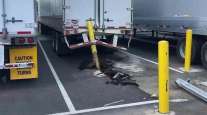Truckers Shun Texas Road With 85-MPH Speed Limit
This story appears in the Dec. 10 print edition of Transport Topics.
The new Texas toll road that has the nation’s fastest speed limit — 85 mph — is rarely used by trucks because it is expensive and has little to offer, carriers said.
State Highway 130 stretches between Austin and Seguin and ends at Interstate 10 east of San Antonio. Toll collection began Nov. 11, after the roadway opened to traffic on Oct. 24.
The private developers and operators of SH130 said traffic figures have not yet been compiled, but trucking executives have been watching the toll road’s traffic patterns.
“I’ve been on it several times already, and there’s not a whole lot of truck traffic on it,” said Barry Detlefsen, who handles safety and security issues for Coastal Transport, a 400-unit tanker fleet based in San Antonio.
A former Texas state trooper, Detlefsen said he documented mileage and driving time on the new highway, compared them with two alternate routes between Austin and San Antonio and found one alternate was 22 miles shorter, the other 14 miles shorter.
So despite a higher speed limit, the less-traveled toll road didn’t save time except when congestion was heavy around Austin, Detlefsen said.
Steve Blake, safety director for R. Wyatt Cos. in San Antonio, said another issue is that the road is too barren for drivers. It goes through sparsely populated areas and ends at the intersection of Interstate 10 in Seguin — 30 to 40 miles east of population centers in San Antonio.
“The new segment of 130 is extremely rural, there is very little there and it is just not an avenue we would travel to deliver to our customers,” Blake said, referring to the Wyatt’s 300-unit fleet hauling sand and gravel.
But John Esparza, president of the Texas Motor Transportation Association, said both the speed differential and the toll are causing carriers to avoid the road.
“Knowing that that speed limit is 85 mph, knowing you have governors on your trucks that are going to be 62, 63, 66 mph, that’s a large disparity, and I know that is a discouragement to companies,” Esparza said.
He added that the new road should attract truckers because “a less congested road is a safer road,” but the tolls are too high.
Truckers pulling one trailer are charged $24.58 to travel the 41-mile stretch between Austin and Seguin, if they have a Texas toll-road tag. Without the tag, they pay $28.10. With two or more trailers, the toll with tag is $30.73 and without is $34.25.
The northern half of SH130, which runs between Austin and Georgetown, is also a toll road but is operated by the state. In an experiment last year, truck tolls were lowered for this portion of the highway for four weeks to see whether trucks would leave other highways. That increased truck traffic on the toll road by 39%.
“It just goes to show you that there are trucks that would use it if the price was right,” Esparza said.
Some carriers also said the high speed limit is not fuel-efficient.
“We govern our equipment to 65 mph,” said Terry Drinnen, senior manager of maintenance and equipment at GST Transport Systems in Houston, one of the nation’s largest auto haulers. “There’s no benefit for our guys to run it,” he said. “You burn a lot more fuel at 85 than you do at 65.”
The speed differential between cars and trucks is another deterrent, carriers said.
Detlefsen said Coastal sometimes routes drivers to the upper half of SH130 operated by the state, when other highways are badly congested. But the speed limit there is 80 mph, which means Coastal must be sure drivers are aware of the danger of having a distracted or inattentive car driver ram the tanker from behind.
An accident on the newest portion of SH130 resulted in a fatality the same day that toll collection began, and there have been other crashes involving wildlife, particularly hogs that freely roam rural areas in South Texas.
“We’ve had nine accidents: four with feral hogs, four with deer and one with a coyote,” said Guadalupe County Sheriff Arnold Zwicke, whose department covers the last 14 miles of the highway.
“If you’re doing 85 mph and you’re trying to avoid hitting that animal, there’s a good chance you’re going to lose control and roll over,” he said.
“To me 55 [mph] was just right because everybody would be driving 70 and then there’d be a perfect world,” Zwicke said.
Chris Lippincott, spokesman for the SH130 Concession Co., the private consortium that built and operates the new toll road, said, “The animals may be learning that the road is a dangerous place to stand.”


